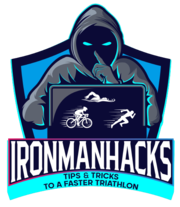It’s hard to plan race times accurately. We have so many biases and there are so many variables that we have to account for.
For the bike, I’ve always loved using BestBikeSplit (see tip #27) and have found it to be pretty accurate, but the swim and the run can be a bit harder to forecast.
The problem is, most humans fall victim to the planning fallacy.
Psychologist Roger Buehler explains it: “People think tasks will be finished quickly and easily because that is what they want to be the case.”
I’ve rarely hit my most optimistic race goals. Call it wishful thinking, overconfidence, or inexperience maybe.
Or maybe it’s the Dunning-Kruger effect. That’s when poor performers can’t recognize their own shortcomings.
Maybe they’re new to the sport and they only know a little bit but then suddenly think they’re experts (I feel this way a lot but that’s more of the imposter syndrome).
This could easily make them overestimate themselves.
Furthermore, research from the American Psychological Association shows that we don’t learn from our mistakes. Even though we know our prior goals were overly optimistic, we keep making more unrealistic predictions.
So in order to counter these misjudgements, I would explore the following four areas. Watch the video below or read the text equivalent below that:
#1. Reflect objectively and honestly.
Are you being objective? Why do you think you can finish in the time you have projected? Are you basing that off of real, past results? Were those results on the same course as the one you’re racing on? Have you considered all that can go wrong in a race?
This one is double-edged. If you use all your fastest efforts and personal bests to do your planning, you’re likely setting yourself up for failure. This will backfire.
Ideally, use times from the same course, if you have done that course. Or, if you have never raced that course, try to find other efforts you’ve done in similar conditions (heat, hills, humidity, rain, cold, etc).
Also, a standalone half marathon with no swim or bike before, even if on the same course, is clearly not a fair representation of your finish time when you have the swim and run beforehand.
You get the idea. Just be honest with yourself.
#2: Get an outsider’s view.
If you have a coach, have him or her give you a brutally honest forecast. Taking an outside view eliminates your own biases.
A good friend could also do this, but only one that knows you well. One that knows your strengths and weaknesses in the three disciplines and your potential. And one that will be brutally honest with you and not sugar-coat anything.
#3: Conduct a pre-moretm.
After racing, I’ve always found value in conducting a post-mortem. I’ll usually do an analysis of what my results were compared to what my goals were.
I’ll cover three main sections: What went well, What went wrong, and Insights & implications.
These come in handy before my next race. Mainly, I look at what I did wrong and try to prevent that from happening again.
But here we’re talking about a pre-mortem, or a pre-race analysis.
Gary Kelin, who came up with the concept of the pre-mortem explains in Harvard Business Review, “Unlike a typical critiquing session, in which project team members are asked what might go wrong, the pre-mortem operates on the assumption that the patient has died, and so asks what did go wrong.”
So in other words, think of all the mistakes you have ever made in the past racing. Also consider external factors like course, climate, and conditions and nutrition.
Assume that what can go wrong will go wrong.
Project yourself into the future imagining that horrible race and think about what you would have to do to prevent those from happening.
The pre-mortem, especially when conducted after an honest assessment of your past performance paired with a coach’s forecast, can uncover your blind spots and help you mitigate failure.
#4: Create an experience map.
Finally, you could consider performing an experience map. This is something I draw from my professional life which reviews an individual’s journey with a product or an event (in this case it’s your race experience).

It helps you identify not only pain-points but also opportunities. It allows you to see the bigger picture.
The experience map charts what you are doing, feeling, and thinking as you race. I would encourage you to map this honestly and try not to paint your best-case scenario, nor the worst.
Download the IronmanHacks experience map template here.
These techniques should help you to manage your optimism bias and better forecast finish times, manage your own expectations, and have a clearer, non-emotional view of yourself.
Related:
Tip #8: Get a coach
Tip #24: Do a post-mortem after your race
Tip #27: Use BestBikeSplit


Leave a Reply
You must be logged in to post a comment.